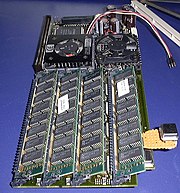PowerUP
The first generation of PowerPC - Amiga systems was 1995/96 of phase5 indirectly through plug-in cards for the CPU slot of the Amiga 4000 (or Amiga 3000 ) and the Amiga 1200 realized. Because of the situation around the parent company Commodore , PowerUP was chosen as the symbolic name .
hardware
These PowerPC-based CPU cards made it possible to accelerate the models of the Amiga series beyond the maximum possible performance (68060: 50/66 MHz) with the available 68k CPUs. The main feature of the cards was the dual CPU architecture: in addition to a 68040/68060 processor, a PowerPC CPU was available on the same plug-in card. They also offered useful features such as additional RAM slots, Fast SCSI or WIDE Fast-20 (ULTRA) SCSI controllers for additional drives and a slot for a graphics card (proprietary local bus, in the case of the BVision with a MiniPCI-like connector ):
- CyberVisionPPC (graphics card for Cyberstorm PPC)
- BVisionPPC (graphics card for Blizzard PPC)
- Cyberstorm PPC (68040/060 and PPC604e accelerator card for A3000 / 4000) with 25/50/66 MHz or 180, 200 or 233 MHz and 64 bit memory access (max. 128 MB)
- Blizzard PPC (68040/060 and PPC603e accelerator card for A1200) with 25/33/40/50 MHz or 160, 210, 240 or 268 MHz with 32 bit memory access (max. 256 MB)
At the very beginning of the development, prototypes of the Cyberstorm PPC cards were distributed to developers, which consisted of converted "conventional" Cyberstorm / 060 cards. A piggyback construction consisting of two circuit boards was used here. The performance data differed from the above.
software
On the software side, PowerUP initially followed a dual approach in which the PowerPC side had to be controlled from the 68k side by a special firmware / kernel (ppc.library). Due to the need for cache synchronization and the shared access to the RAM when exchanging data between the CPUs, programming was on the one hand time-consuming and the performance gain achieved with standard applications was often low. Good acceleration effects resulted with skilful programming z. As with sealed codecs for graphics / animation formats (PNG, JPEG, GIF, MPEG) or compression libraries (libz), mostly in the form of suitably adapted AmigaOS - datatypes .
This situation only improves with the use of MorphOS or other operating systems.
successor
On the software side, the MorphOS operating system of the Pegasos I / II computer is to be understood as the successor to PowerUP. MorphOS is now also available for PowerUP cards and the initial disadvantages of the dual architecture are avoided by means of the ppc-side 68k emulation integrated there - similar to the Powermac . The existing 68040/68060 CPU is simply deactivated after starting MorphOS.
Another successor to the PowerUP approach are the AmigaOne computers from Amiga, Inc. - these are to be understood as the successors of the WarpUP system (with its powerpc.library) competing with PowerUP , which was then used by Haage & Partner against the will of phase5 was established as a competitive system to PowerUP.
Alternative operating systems
Linux porting is also available for all the systems mentioned .

